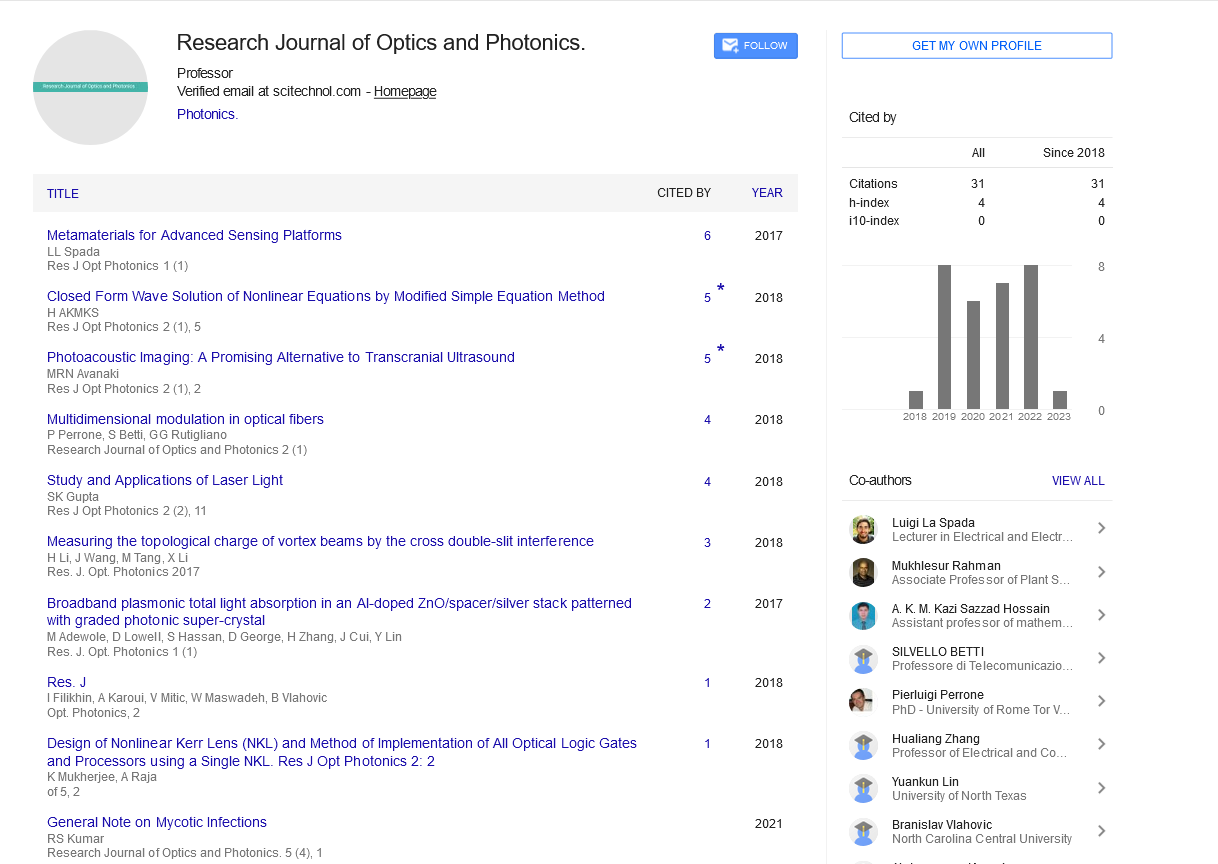Opinion Article, Vol: 7 Issue: 2
Photonics: The Science and Technology of Harnessing Light for Information Processing
Sergay Kudryushov*
1Department of Physics, National Research Nuclear University, Moscow, Russia
*Corresponding Author: Sergay Kudryushov,
Department of Physics,
National
Research Nuclear University, Moscow, Russia
E-mail: kudryushov38@gmail.com
Received date: 03 June, 2023, Manuscript No. RJOP-23-107614;
Editor assigned date: 05 June, 2023, PreQC No. RJOP-23-107614 (PQ);
Reviewed date: 19 June, 2023, QC No. RJOP-23-107614;
Revised date: 26 June, 2023, Manuscript No. RJOP-23-107614 (R);
Published date: 03 July, 2023 DOI: 10.4172/RJOP.1000054
Citation: Kudryushov S (2023) Photonics: The Science and Technology of Harnessing Light for Information Processing. Res J Opt Photonics 7:2.
Abstract
Description
Photonics, the science and technology of harnessing light, has revolutionized information processing by providing fast, efficient, and scalable solutions. This manuscript explores the fundamental principles, advanced technologies, and applications of photonics in information processing. We discuss key components such as lasers, optical fibers, and photonic integrated circuits, along with their role in optical communication systems. Furthermore, we delve into emerging technologies, including all-optical signal processing, quantum photonics, and integrated photonics for data processing and storage. By harnessing the power of light, photonics continues to push the boundaries of information processing, paving the way for future advancements. Photonics, the science and technology of light, has transformed information processing by enabling fast and efficient solutions. This provides an in-depth exploration of photonics in information processing, focusing on its principles, technologies, and applications.
Fundamentals of photonics
This section introduces the fundamental principles of photonics, including the behavior of light, electromagnetic waves, and the interaction of light with matter. We discuss key concepts such as reflection, refraction, diffraction, interference, and polarization, which form the basis of photonics.
Key components in photonics
Photonics relies on various key components that enable the manipulation and control of light. In this section, we explore the following components:
Lasers: We discuss the principles and types of lasers, including semiconductor lasers, solid-state lasers, and fiber lasers. Lasers play a crucial role in generating coherent and intense light sources for a wide range of applications in information processing.
Optical fibers: Optical fibers are essential for transmitting optical signals over long distances with minimal loss. We delve into the principles of light propagation in fibers, fiber types, and fiber-based communication systems.
Photonic Integrated Circuits (PICs): PICs are miniaturized devices that integrate multiple optical components onto a single chip.
We discuss the design, fabrication, and applications of PICs, which enable high-density and highly functional optical systems.
Optical communication systems
Optical communication systems form the backbone of modern information processing, providing high-speed and long-distance data transmission. This section explores the following aspects of optical communication systems:
Modulation techniques: We discuss modulation formats, such as amplitude modulation, frequency modulation, and phase modulation, which are used to encode information onto optical carriers.
Optical fiber communication: We explore the principles of optical fiber communication, including signal propagation, dispersion compensation, and Wavelength Division Multiplexing (WDM). Additionally, we discuss emerging technologies in fiber communication, such as Space-Division Multiplexing (SDM) and Mode-Division Multiplexing (MDM).
Optical networks: We delve into optical network architectures, including Passive Optical Networks (PONs), Wavelength-Division Multiplexing (WDM) networks, and Reconfigurable Optical Add- Drop Multiplexers (ROADMs).
All-optical signal processing offers the potential for ultrafast and energy-efficient information processing. This section discusses recent advancements in all-optical signal processing techniques, including optical switching, wavelength conversion, and signal regeneration. We also explore applications such as all-optical logic gates and all-optical signal processing for high-speed optical networks.
Quantum photonics
Quantum photonics combines the principles of photonics and quantum mechanics, offering unique capabilities for information processing. This section explores quantum photonics, including the generation and manipulation of single photons, quantum cryptography, and quantum information processing using photonic qubits.
Integrated photonics for data processing and storage
Integrated photonics involves the integration of photonic components on a chip, enabling compact and scalable systems for data processing and storage. This section discusses emerging technologies in integrated photonics, including Photonic Integrated Circuits (PICs) for data processing, silicon photonics for on-chip communication, and photonic memories for high-density storage.
Applications of photonics in information processing
This section highlights the applications of photonics in information processing:
Data centers: We explore the use of photonics in high-speed data centers, including optical interconnects, Wavelength Division Multiplexing (WDM), and photonic switching technologies.
Optical computing: We discuss the potential of photonics for optical computing, including all-optical logic gates, optical neural networks, and photonic processors for parallel computing.
Photonic sensors: Photonics plays a crucial role in sensing and data acquisition, including applications in telecommunications, healthcare, environmental monitoring, and industrial sensing.
Challenges and future directions
This section discusses the challenges and future directions in photonics for information processing. We explore topics such as increasing data rates, reducing power consumption, integrating photonics with other technologies (e.g., electronics and nanotechnology), and exploring new materials and fabrication techniques.
Conclusion
The recent advances in optics and photonics are propelling us toward new frontiers of knowledge and applications. From quantum optics to nanophotonics, these advancements have the potential to revolutionize various fields, including telecommunications, medicine, energy, and sensing. By continually pushing the boundaries of lightbased technologies, researchers and engineers are driving progress in science, technology, and innovation, offering a promising future for optics and photonics.
 Spanish
Spanish  Chinese
Chinese  Russian
Russian  German
German  French
French  Japanese
Japanese  Portuguese
Portuguese  Hindi
Hindi 